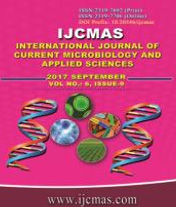


 National Academy of Agricultural Sciences (NAAS)
National Academy of Agricultural Sciences (NAAS)

|
PRINT ISSN : 2319-7692
Online ISSN : 2319-7706 Issues : 12 per year Publisher : Excellent Publishers Email : editorijcmas@gmail.com / submit@ijcmas.com Editor-in-chief: Dr.M.Prakash Index Copernicus ICV 2018: 95.39 NAAS RATING 2020: 5.38 |
India is the land of Spices, the largest producer, consumer and exporter of the spices in the world. According to the Spice Board of India, sixty three spices are grown in the country. More than 90% of spices produced in India are used for domestic consumption and the remaining are exported in raw and value added forms. A spice is a seed, fruit, root, bark, or other plant substance primarily used for flavouring, colouring or preserving food. Spices are distinguished from herbs, which are the leaves, flowers, or stems from plants used for flavouring or as a garnish. Sometimes, spices may be ground into a powder for convenience. Many spices have antimicrobial properties. This may explain why spices are more commonly used in warmer climates, which have more infectious diseases, and why the use of spices is prominent in meat, which is particularly susceptible to spoiling. India produces spices on 3.08 million ha with and annual production of about 5.4 million tons valued at about Rs. 4500 crores, contributing nearly 20% of world’s production, 30% of the trade in terms of quantity but only 10% in terms of value. India is the biggest exporter of spices and annually exporting about 3,908 tones of spices and spice products valued around Rs. 4,460 crores. (NHB Database)The major constraints of spice production includes- Low farm productivity and consequent high cost of production, Non-coverage of high yielding varieties in farmers’ fields, Non-availability of quality planting materials of high yielding varieties, Crop loss due to sever diseases and pest incidences, Poor post-harvest handlings, Inadequate extension networks and Price instability. More over the traditional method of propagation in spice crops is followed the advance techniques for rapid multiplication like split bamboo method, serpentine method, soil mound method, in black pepper propagation and propagation of turmeric and ginger using single bud rhizomes and rapid clonal propagation techniques in high value crops like small cardamom and in-vitro propagation of crops like vanilla and cinnamon can be adopt for better utilization of land and supply of quality planting material (QMP).Hence the major bottle neck of the spice production is due to unavailability of quality planting material. Keeping this constraints in mind the advance propagation techniques can be adopt to overcome this problem.
 |
 |
 |
 |
 |